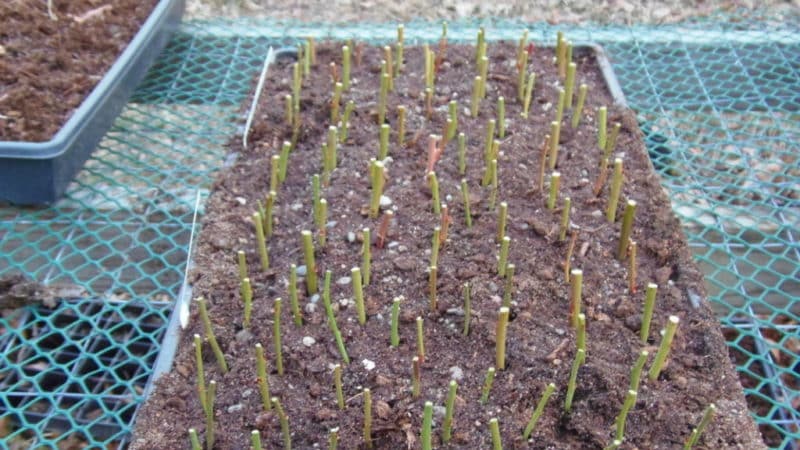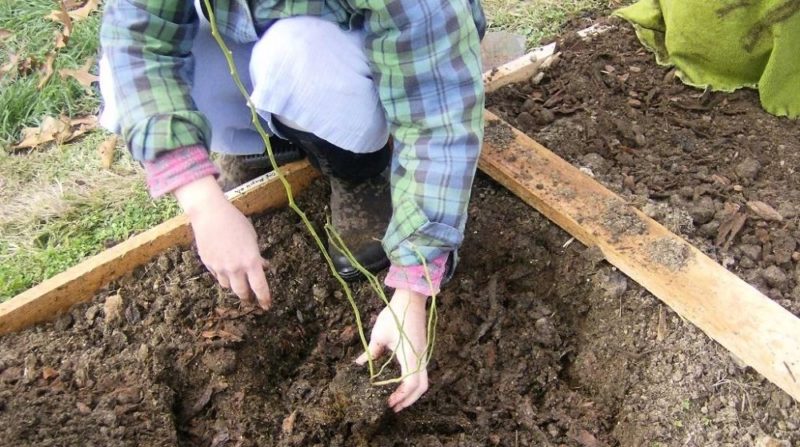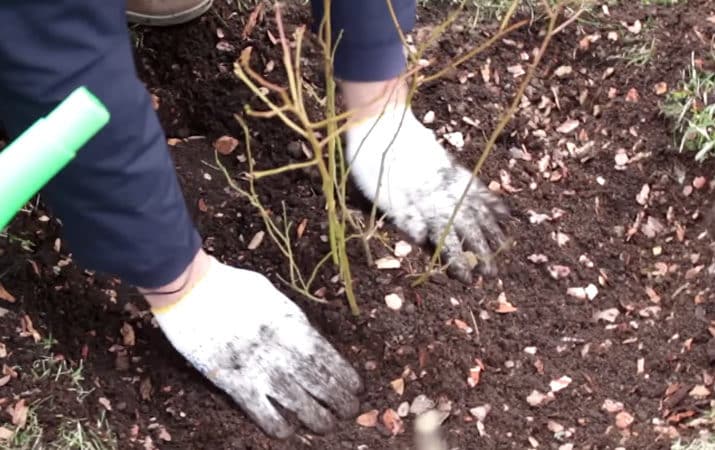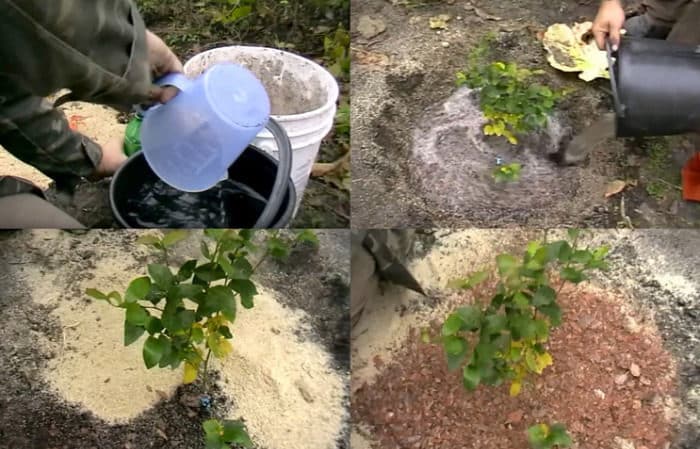Instructions for planting blueberry seedlings in open ground in spring
Blueberries are recognized as one of the healthiest garden berries. It is used in folk medicine, cosmetology and cooking. The berries are sold fresh and frozen, but the best blueberries are those grown in your own garden. Moreover, planting shrubs does not require special preparation; any novice gardener can cope with this simple task. How to properly plant garden blueberries in open ground and what recommendations to follow, we will consider further.
Features of blueberry propagation by seedlings
To propagate blueberries, one- or two-year-old seedlings with closed roots are used. The advantage of this method is that the seedlings produce a harvest the following year after landing. Propagation by seedlings is used not only by amateur gardeners, but also by farmers for sale. You can buy blueberry seedlings in specialized stores. Manufacturers prepare planting material using cuttings.

The cuttings are cut, stored in a bag, and placed in greenhouses to form buds. When they take root, they are hardened off - the greenhouse is often ventilated so that in the future the plants have strong immunity. Another feature is that blueberries are difficult to take root, so before planting, summer residents use growth stimulants, for example, Kornevin.
When is it better to plant - in spring or autumn?
Blueberries are planted both in autumn and spring. Still, spring planting is preferable.The plant is planted at the end of March or beginning of April until the buds swell. It is better to do this when the snow has just melted and the soil is still slightly damp, and the air has warmed up to +5°C.
In spring, seedlings quickly adapt to climatic conditions, which will have a positive effect on the future harvest.
When to plant blueberries in spring

Choose a sunny morning for planting. There should be no wind, rain or snow. The lunar calendar will help you choose the date. It is believed that blueberries do not take root well if planted during a new or full moon.
In 2020, favorable days for planting blueberries are April 24 and 25 or the period from May 2 to May 10. These days are characterized as fertile.
Attention! Most blueberry seedlings are sold in containers. The plant has a delicate root system, so the container protects it from damage.
Selection and preparation of seedlings, planting sites and soil
When choosing a seedling, pay attention to the variety. It is important that it matches the region. For example, frost-resistant plants with strong immunity are chosen for the Urals and Siberia, and drought-resistant plants for the Volga region. The optimal height of a seedling is 35 cm. When purchasing, pay attention not only to its age, but also to its appearance. It should be elastic, without stains, cracks or other damage. Otherwise, it will not take root well on the site. Before planting on the site, the plant is watered abundantly with water.
Blueberries are demanding of sunlight, so they are planted in even rows from north to south. The place should be spacious and well lit. Due to lack of light, the berries will grow small and sour. Also, do not plant the plant in lowlands. When growing low-growing varieties, maintain a distance of 60 cm between bushes, and from 1 to 1.5 m when growing tall varieties.The distance between rows must be at least 2 m.
Holes for blueberries are prepared 10 days before planting to allow the soil to settle. Diameter - about 70 cm, round shape, depth - 60 cm. The best type of soil is sandy and peaty. A drainage layer is made at the bottom of the hole, since blueberries do not tolerate stagnant water. Branches or large coniferous bark are used as drainage. Unlike most garden shrubs, blueberries grow well in acidic soils with a pH of 3-4. To acidify the soil, use citric or oxalic acid at the rate of 1 tsp. acid per 3 liters of water.
Attention! Before planting, the prepared holes are filled with an acidic substrate - a mixture of peat, sawdust, sand, and sulfur is added. It is important to remember that blueberries do not tolerate organic substances - compost, manure, humus. Therefore, blueberries are planted away from plants that regularly need organic matter (currants, raspberries, cherries).
How to plant blueberries in spring

In order for blueberries to please you with the harvest and not get sick, it is important to follow the recommendations of experienced agronomists.
Step-by-step instructions for planting blueberries in the garden:
- remove the seedling from the container, give the roots a horizontal position;
- Gently knead the earthen lump and spread the roots to the sides;
- make a small mound in the center of the prepared planting hole;
- put a seedling in it, sprinkle it with soil and compact the soil at the base;
- water the plant generously, add the remaining soil mixture;
- mulch the blueberries with a 4 cm layer.
Good neighborhood with other plants
Successful neighbors for blueberries are plants that love acidic soil. Decorative crops include heather and hydrangea, and coniferous crops include juniper and fir.
Among fruit bushes, cranberries and lingonberries coexist with blueberries; among vegetables, potato and sorrel. Garden greens are also planted nearby.
Unsuitable neighbors are plants that prefer neutral soil. This apple trees, pears, strawberries, gooseberry, melons, carrot, eggplants.
What mistakes to avoid
Sometimes gardeners neglect the rules and plant blueberries without checking the acidity of the soil. As a result, the bush bears fruit poorly and is affected by diseases and pests. To prevent this from happening, it is important to check the pH and acidify the soil. In this case, the pH should not be higher than 5.5, since in this case the leaves become light green and do not absorb nitrogen fertilizers well.
If you do not knead the root ball when planting, blueberries will not grow. The seedling in the pot is placed in water for 3-4 hours to soak the lump. It is also important not to grow blueberries in garden soil; it is recommended to prepare a substrate from peat and sawdust in advance.
Features of planting in different growing regions

Planting features depend not so much on the growing region, but on the condition of the soil. For example, in the Urals and Siberia, the soils are not fertile and require careful preparation. The soil is fertilized and acidified, and a drainage layer is prepared.
It is not recommended to make drainage from crushed stone - it neutralizes acidity. If the shrub is grown in a windy area, garden protective strips are constructed in advance. This could be a fence, a country house, a hedge. It is important to remember that protective objects should not block the penetration of light.
When growing in the middle zone or southern regions, there are no special requirements. The main thing is to allocate a spacious and sunny area for blueberries. If the planting schemes and proximity to other plants are observed, the shrubs bear fruit consistently and rarely get sick, and have time to ripen before the onset of frost. In the northern regions, they prefer to grow low-growing varieties, in the southern regions - medium- and tall-growing ones.
Further care

Water blueberries twice a week, using a bucket of water per bush. The planting hole is kept moist, otherwise blueberries will not bear fruit well in the next 2-3 years. For watering, use a watering can - it does not wash away the mulch, as happens when watering with a hose. If the summer is hot, in addition to watering three times a week, blueberries are sprayed with water from a spray bottle. They do this in the afternoon. Spraying protects the plant from overheating and stimulates photosynthesis.
In addition to hydration, garden blueberries need mineral supplements.. They are applied twice per season with an interval of 5-6 weeks. One bush requires 90 g of ammonium sulfate, 30 g of potassium sulfate, 200 g of ready-made complex fertilizer “Kemira Universal”. With the beginning of sap flow, the shrub is fed with azophoska or “Good Power” fertilizer. Fertilizers are diluted in water and poured at a distance of 15 cm from the bush. If they are used dry, then they are laid out between the rows.
Summer residents keep their beds clean - Blueberries do not tolerate weeds and debris. They loosen the soil every week, while making sure that there is always mulch under the bushes. A thick layer of sawdust and pine needles prevents weeds from growing. And if any weeds break through, they are removed by hand. The depth of loosening should be no more than 3 cm.
This is interesting:
Step-by-step instructions for pruning blueberries in spring for beginner gardeners
Honeysuckle variety Blue spindle: variety description, planting and care
Conclusion
Blueberries are grown in gardens in the Moscow region, Ivanovo region, Kuban, St. Petersburg, and Krasnodar region. In other words, all over the country. The berry is valued for its decorative appearance, taste and benefits. Planting blueberry seedlings begins in the spring - in March and April.
The plant prefers acidic soil, so it is important to check the pH level first. For planting, select a windless, sunny place, dig a hole and fertilize it. The roots of the seedling are straightened and placed in a hole, sprinkled with water and watered abundantly. For a good harvest, it is recommended to plant lingonberries, sorrel, and cranberries nearby. It is better to avoid proximity to apple and pear trees.
This year I planted blueberries for the first time according to your recommendations. From your article I now know how to care for her. Thank you for the article.